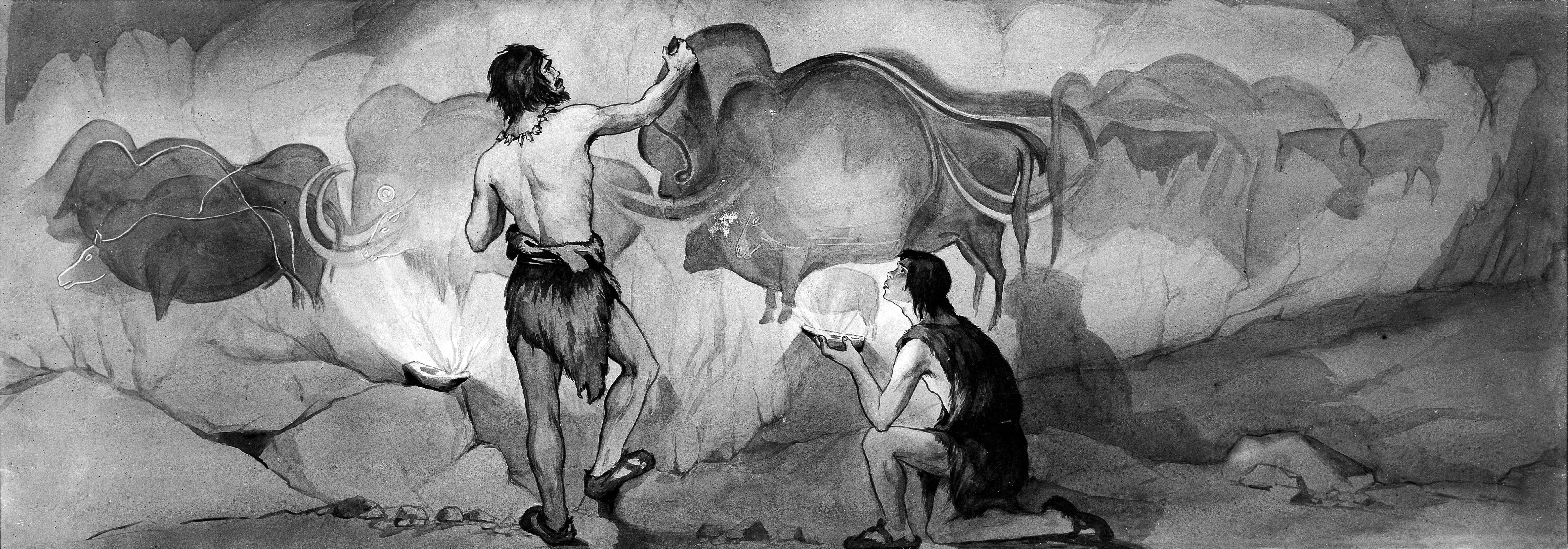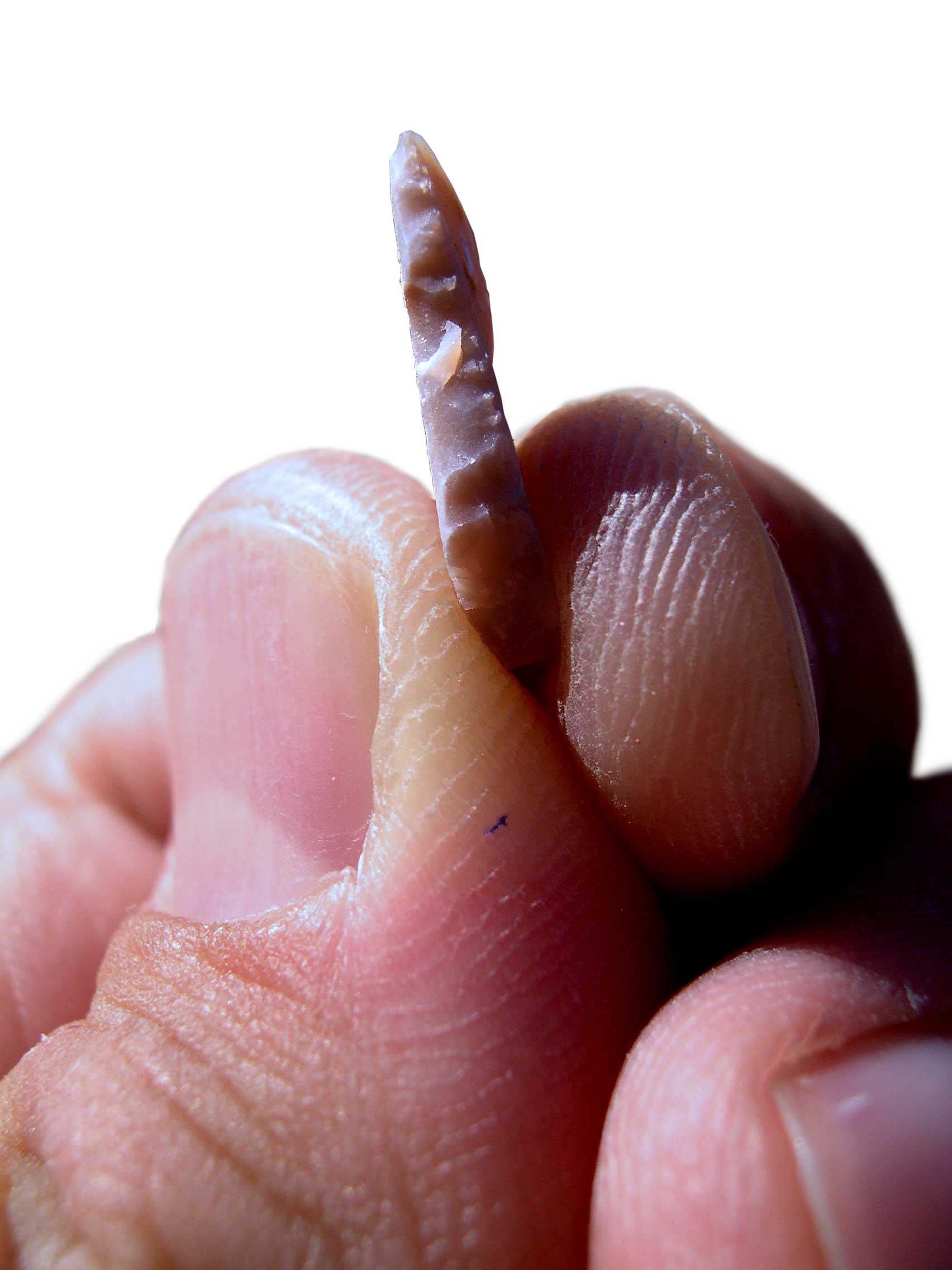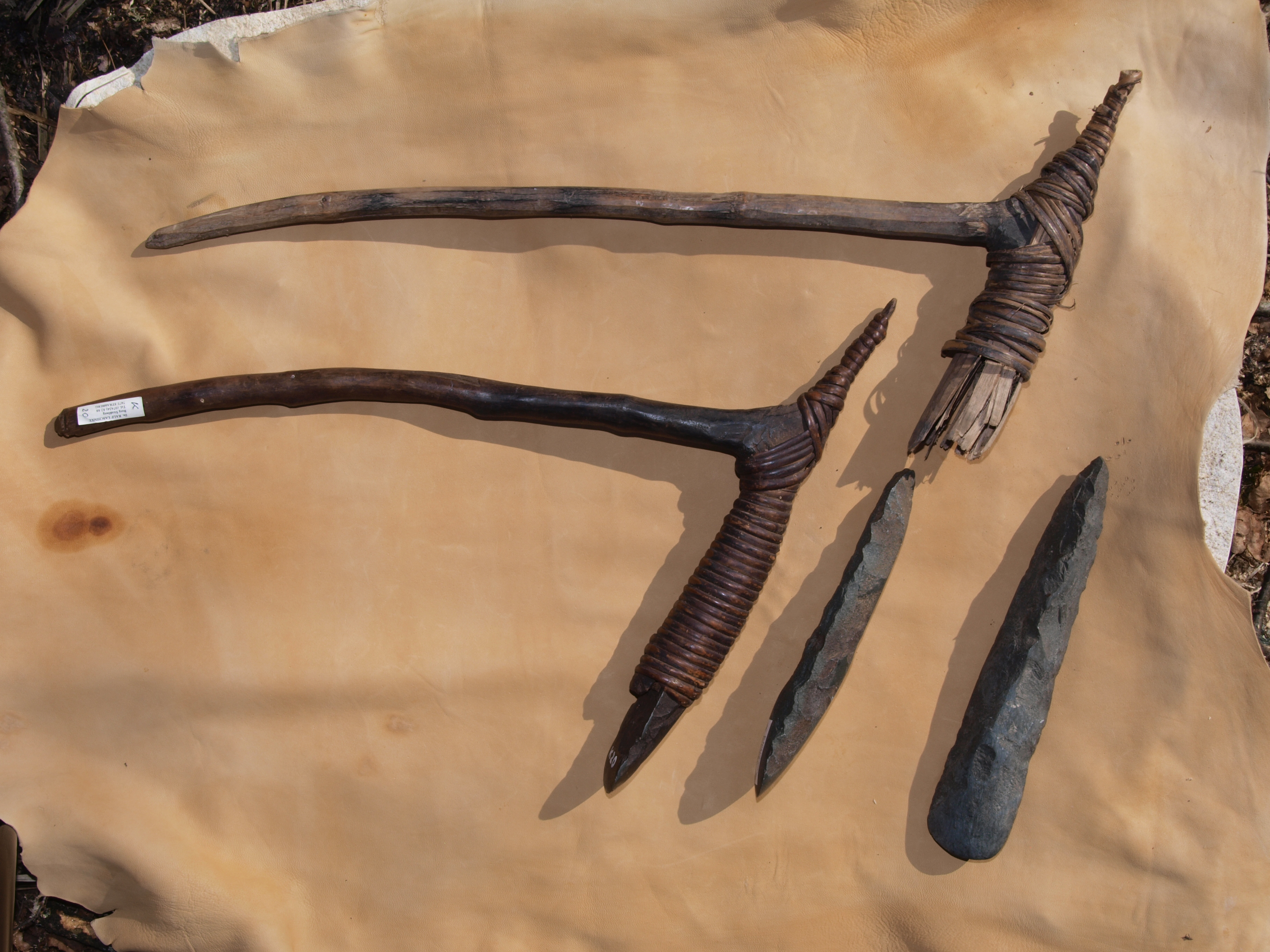|
Bockstein Cave
The Bockstein Cave, is part of the ''Bockstein complex'' – a White Jurassic limestone rock massif. The rock shelter, among small peripheral caves is situated around above the Lone River valley bottom, north of the towns of Rammingen and Öllingen, Heidenheim district in the central Swabian Jura, southern Germany. Several small openings, that are the actual entrances to the site, lead to various cave sections. The large frontal opening is of modern origin, created during the first excavation works in the late 19th century. Among Mesolithic and Neolithic stone tools and artefacts numerous bone fossils, that date back 50,000 to 70,000 years were found, making the location the oldest known settlement complex of Neanderthals in southern Germany. Moreover, the ca. 8,000 year old and relatively well preserved skeletons of a woman and an infant were discovered. Because of its historical and cultural significance and its testimony to the development of Paleolithic culture, the cave ... [...More Info...] [...Related Items...] OR: [Wikipedia] [Google] [Baidu] |
Lone (river)
The Lone is a river in Baden-Württemberg, Germany. It flows into the Hürbe river, a tributary of the Brenz, which in turn discharges into the Danube. Course The Lone rises from a Karst spring with a large discharge near Urpsring, in the municipality of Lonsee, Baden-Württemberg. It flows southeast and then turns northeast. After around 37 km it flows into the Hürbe, which in turn is a tributary of the Brenz. The valley of the Lone is fairly shallow, with rises of only around 50 m on both sides. The valley's width is up to 200 m. The flat valley floor is covered by meadows and fields, the slopes of reef limestone are mostly wooded. The karst on the slopes contains various caves and protuberances which were repeatedly visited by prehistoric hunter/gatherer groups as long ago as the Paleolithic and post-Ice Age Mesolithic. Among these are the Bocksteinhöhle, Hohlenstein-Stadel and Vogelherd Cave, locations of important pre-historic findings. See also *List of rive ... [...More Info...] [...Related Items...] OR: [Wikipedia] [Google] [Baidu] |
Neanderthal
Neanderthals ( ; ''Homo neanderthalensis'' or sometimes ''H. sapiens neanderthalensis'') are an extinction, extinct group of archaic humans who inhabited Europe and Western and Central Asia during the Middle Pleistocene, Middle to Late Pleistocene. Neanderthal extinction occurred roughly 40,000 years ago with the immigration of modern humans (Cro-Magnons), but Neanderthals in Gibraltar may have persisted for thousands of years longer. The first recognised Neanderthal fossil, Neanderthal 1, was discovered in 1856 in the Neander Valley, Germany. At first, Neanderthal 1 was considered to be one of the racial hierarchy, lower races in accord with historical race concepts. As more fossils were discovered through the early 20th century, Neanderthals became characterised most especially by Marcellin Boule as a unique species of underdeveloped human. By the mid-20th century, human evolution was described as progressing from an apelike ancestor, through a "Neanderthal phase", ending ... [...More Info...] [...Related Items...] OR: [Wikipedia] [Google] [Baidu] |
Prehistoric Sites In Germany
Prehistory, also called pre-literary history, is the period of human history between the first known use of stone tools by hominins million years ago and the beginning of recorded history with the invention of writing systems. The use of symbols, marks, and images appears very early among humans, but the earliest known writing systems appeared years ago. It took thousands of years for writing systems to be widely adopted, with writing having spread to almost all cultures by the 19th century. The end of prehistory therefore came at different times in different places, and the term is less often used in discussing societies where prehistory ended relatively recently. It is based on an old conception of history that without written records there could be no history. The most common conception today is that history is based on evidence, however the concept of prehistory hasn't been completely discarded. In the early Bronze Age, Sumer in Mesopotamia, the Indus Valley Civilis ... [...More Info...] [...Related Items...] OR: [Wikipedia] [Google] [Baidu] |
Hohle Fels
The ''Hohle Fels'' (; also ''Hohlefels'', ''Hohler Fels'', German for "hollow rock") is a cave in the Swabian Jura of Germany that has yielded a number of important archaeological finds dating from the Upper Paleolithic. Artifacts found in the cave represent some of the earliest examples of prehistoric art and musical instruments ever discovered. The cave is just outside the town of Schelklingen in the state of Baden-Württemberg, near Ulm. Because of the outstanding archeological finds and their cultural significance, in 2017 the site became part of the UNESCO World Heritage Site Caves and Ice Age Art in the Swabian Jura. Discoveries The first excavation took place in 1870, yielding remnants of cave bears, reindeer, mammoths and horses as well as tools belonging to the Aurignacian culture of the Upper Paleolithic. Further excavations during 1958 to 1960, 1977, and 2002 yielded a number of spectacular finds, including several specimens of prehistoric sculpture such as ... [...More Info...] [...Related Items...] OR: [Wikipedia] [Google] [Baidu] |
Vogelherd Cave
The Vogelherd Cave ( , or simply ''Vogelherd'') is located in the eastern Swabian Jura, south-western Germany. This limestone karst cave came to scientific and public attention after the 1931 discovery of the Upper Palaeolithic ''Vogelherd figurines'', attributed to Paleoanthropology, paleo-humans of the Aurignacian culture. These miniature sculptures made of mammoth ivory rank among the oldest uncontested works of art of mankind. Because of the cultural importance of these sculptures and the cave's testimony to the development of Paleolithic art and culture, in 2017 the site became part of the UNESCO World Heritage Site called Caves and Ice Age Art in the Swabian Jura. Location The site is located on the edge of the valley of the river Lone (river), Lone near Stetten ob Lontal, part of Niederstotzingen in the eastern Swabian Jura, Baden-Württemberg, southern Germany. It is not publicly accessible, but since 2013 has been embedded in the ''Archäopark Vogelherd'' that includ ... [...More Info...] [...Related Items...] OR: [Wikipedia] [Google] [Baidu] |
Brillenhöhle
The Brillenhöhle (, literally ''spectacles cave'') is a cave ruin, located west of Ulm on the Swabian Alb in south-western Germany, where archaeological excavations have documented human habitation since as early as 30,000 years ago. Excavated by Gustav Riek from 1955 to 1963, the cave's Upper Paleolithic layers contain a sequence of Aurignacian, Gravettian and Magdalenian artifacts. In 1956 the first human fossils were discovered within a fireplace in the center of the cave, a discovery which made important contributions to the foundational understanding of the Magdalenian culture of central Europe. Site Brillenhöhle is located in the Ach Valley, lying about above the Ach River below. The site derives its name from the two holes in the cave's ceiling, which together resemble a pair of spectacles. The cave is essentially a single room with a diameter of , an average height of and a length of . A small side cave of width and height, called ''Vespershöhle'' runs from the ... [...More Info...] [...Related Items...] OR: [Wikipedia] [Google] [Baidu] |
Museum Ulm
The Museum Ulm (Museum der Stadt Ulm), founded in 1924, is a museum for art, archeology, urban and cultural history in Ulm, Germany. Exhibits range from prehistoric and early archaeological finds of the Ulm region (including the lion-man statuette) to Late (International) Gothic and Renaissance paintings and sculptures made in Ulm and Upper Swabia. Collections of 16th-to-19th-century artisan works by Ulm's handicraft guilds are also presented. Conservator and university professor Julius Baum became the museum’s founding director and its first art historian on 1 April 1924. According to his successor Erwin Treu, "this started the real history" as "an institute emerged from a junk room". Exhibits Prehistory The museum's permanent archaeological exhibition was redesigned in 2014 after further fragments of a 35,000 to 41,000-year-old mammoth ivory sculpture were recovered at the original site in the Lone Valley. This lion-man figurine is a human with the head and the limbs ... [...More Info...] [...Related Items...] OR: [Wikipedia] [Google] [Baidu] |
Magdalenian
Magdalenian cultures (also Madelenian; ) are later cultures of the Upper Paleolithic and Mesolithic in western Europe. They date from around 17,000 to 12,000 years before present. It is named after the type site of Abri de la Madeleine, a rock shelter () located in the Vézère valley of Tursac in Dordogne, France. Édouard Lartet and Henry Christy originally termed the period ''L'âge du renne'' "the age of the reindeer". They conducted the first archaeological excavation of the type site, publishing in 1875. The Magdalenian is associated with reindeer hunters. Magdalenian sites contain extensive evidence for the hunting of red deer, wild horses, and other megafauna present in Europe toward the end of the Last Glacial Period. The culture was geographically widespread, and later Magdalenian sites stretched from Portugal in the west to Poland in the east, and as far north as France, the Channel Islands, England, and Wales. Besides la Madeleine, the chief stations of the Ma ... [...More Info...] [...Related Items...] OR: [Wikipedia] [Google] [Baidu] |
Microlithic Culture
A microlith is a small stone tool usually made of flint or chert and typically a centimetre or so in length and half a centimetre wide. They were made by humans from around 60,000 years ago, across Europe, Africa, Asia and Australia. The microliths were used in spear points and arrowheads. Microliths are produced from either a small blade ( microblade) or a larger blade-like piece of flint by abrupt or truncated retouching, which leaves a very typical piece of waste, called a microburin. The microliths themselves are sufficiently worked so as to be distinguishable from workshop waste or accidents. Two families of microliths are usually defined: laminar and geometric. An assemblage of microliths can be used to date an archeological site. Laminar microliths are slightly larger, and are associated with the end of the Upper Paleolithic and the beginning of the Epipaleolithic era; geometric microliths are characteristic of the Mesolithic and the Neolithic. Geometric microliths may be ... [...More Info...] [...Related Items...] OR: [Wikipedia] [Google] [Baidu] |
Adzes
An adze () or adz is an ancient and versatile cutting tool similar to an axe but with the cutting edge perpendicular to the handle rather than parallel. Adzes have been used since the Stone Age. They are used for smoothing or carving wood in hand woodworking, and as a hoe for agriculture and horticulture. Two basic forms of an adze are the hand adze (short hoe)—a short-handled tool swung with one hand—and the foot adze (hoe)—a long-handled tool capable of powerful swings using both hands, the cutting edge usually striking at foot or shin level. A similar tool is called a mattock, which differs by having two blades, one perpendicular to the handle and one parallel. History Africa The adze is depicted in ancient Egyptian art from the Old Kingdom onward. Originally the adze blades were made of stone, but already in the Predynastic Period copper adzes had all but replaced those made of flint. Stone blades were fastened to the handle by tying and early bronze blades cont ... [...More Info...] [...Related Items...] OR: [Wikipedia] [Google] [Baidu] |
Celt (tool)
In archaeology, a celt is a long, thin, prehistoric, stone or bronze tool similar to an adze, hoe, or axe. A shoe-last celt was a polished stone tool used during the early European Neolithic for felling trees and woodworking. Etymology The term "celt" seems to have come about from a copyist's error in many medieval manuscript copies of Job 19:24 in the Latin Vulgate Bible, which became enshrined in the authoritative Sixto-Clementine printed edition of 1592. Where all earlier versions (the Codex Amiatinus, for example) have ''vel certe'' (the Latin for 'but surely'), the Sixto-Clementine has ''vel celte''. The Hebrew has לעד (''lā‘aḏ'') at this point, which means 'forever'. The editors of the Oxford English Dictionary " nclineto the belief that ''celtis'' was a phantom word", simply a misspelling of ''certe''. However, some scholars over the years have treated ''celtis'' as a real Latin word. From the context of Job 19:24 ("Oh, that my words were inscribed with an ... [...More Info...] [...Related Items...] OR: [Wikipedia] [Google] [Baidu] |



